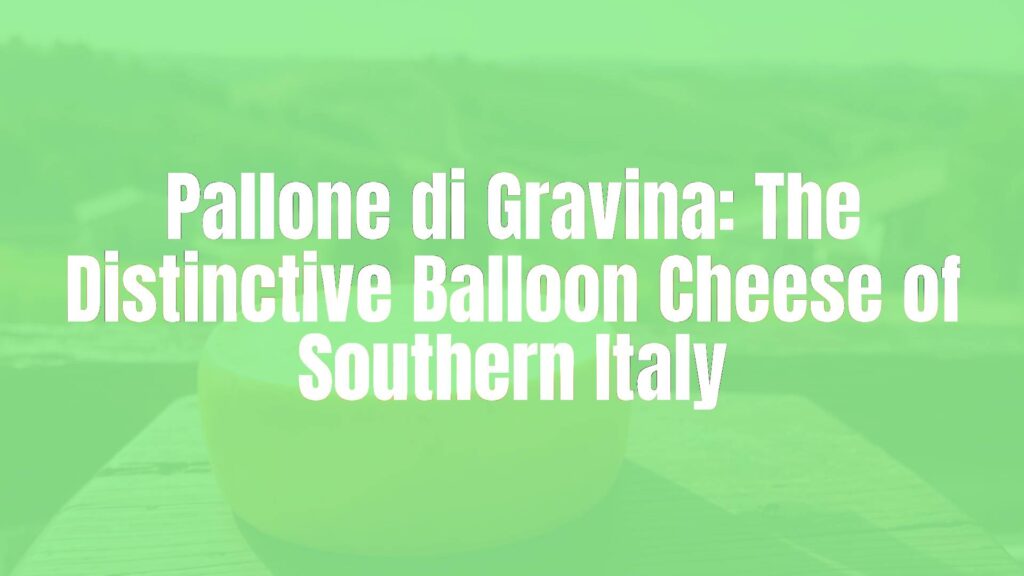Introduction to Pallone di Gravina
Pallone di Gravina is a cherished Italian cheese hailing from the region of Apulia (Puglia), particularly around the town of Gravina in Puglia and the neighboring territories of Basilicata. Easily recognized by its characteristic sphere or “balloon” shape, this semi-hard cheese encapsulates centuries of tradition and a flavor profile prized by cheese enthusiasts throughout Italy and beyond.
Distinguishing Characteristics
What sets Pallone di Gravina apart is its firm, elastic texture and a flavor that perfectly balances savory, nutty, and faintly tangy notes. The cheese is typically made from cow’s milk, although historically, a blend incorporating sheep’s or goat’s milk was sometimes used depending on local availability. Its outer rind is smooth and yellow to brownish in color, forming naturally during its aging process, while the interior remains pale and aromatic.
Historical Context and Origins
References to Pallone di Gravina date back several centuries, appearing in writings from the 18th and 19th centuries describing the cheese as a prized product exported from Southern Italy. It was traditionally made in rural areas where it was valued for its long shelf-life and ease of transport—its distinctive balloon shape made it easy to tie and hang in storage for slow maturation. The cheese played a notable role in local agrarian economies, enjoyed by both local farmers and the nobility.
Traditional Production Methods
The making of Pallone di Gravina involves a classic pasta filata (stretched-curd) technique. Freshly collected raw cow’s milk—or occasionally a mix with sheep’s or goat’s milk—is coagulated and cut, then heated and stretched to develop its unique texture. The curds are carefully molded into large, rounded forms, often weighing between 1.5 to 4 kilograms. The cheese is then briefly salted and aged for periods ranging from a few weeks up to several months, depending on the desired flavor intensity.
Pallone di Gravina in Local Culture
This cheese is more than just a delicacy; it is a symbol of local heritage and agricultural identity. Affectionately referred to as “Pallone” (meaning “ball” in Italian), it is often featured during festivals and regional fairs celebrating the rich culinary traditions of Apulia. It stands as a testament to the region’s resourcefulness and pride in high-quality, artisanal food products.
Culinary Uses and Pairings
Pallone di Gravina is exceptionally versatile in the kitchen. Its semi-hard consistency allows it to be sliced, cubed, or grated over dishes. It is frequently enjoyed on its own, accompanied by rustic bread, olives, or sun-dried tomatoes. The cheese’s distinctive tang enhances baked pasta dishes, vegetable casseroles, and savory pies. Locals often recommend pairing Pallone di Gravina with robust southern Italian red wines such as Primitivo or Aglianico, which complement its layered flavor.
Serving Suggestions & Tips
To savor Pallone di Gravina at its best, serve it at room temperature to allow its flavors and aromas to fully develop. It can be added to antipasti platters or as a delectable table cheese during gatherings. For a regional touch, thin slices can be drizzled with local olive oil or accompanied by seasonal fruit.
Variations and DOP Status
While there is a general appreciation for artisanal and traditional methods, there are slight variations in recipes and production between families and cheesemakers. Some variations may use slightly different milk blends or adjust the aging time for a unique flavor profile. Pallone di Gravina is included in the official list of traditional Italian agri-food products (PAT), highlighting its cultural and gastronomic significance.
Conclusion
Pallone di Gravina exemplifies the diversity and depth of Italian cheesemaking. Its unique shape, enduring traditions, and ability to elevate everyday meals make it a treasured component of Southern Italian cuisine. Whether enjoyed as part of a rustic meal or on an elegant cheese board, this cheese invites you to explore the tastes and stories of Apulia’s rolling countryside.

